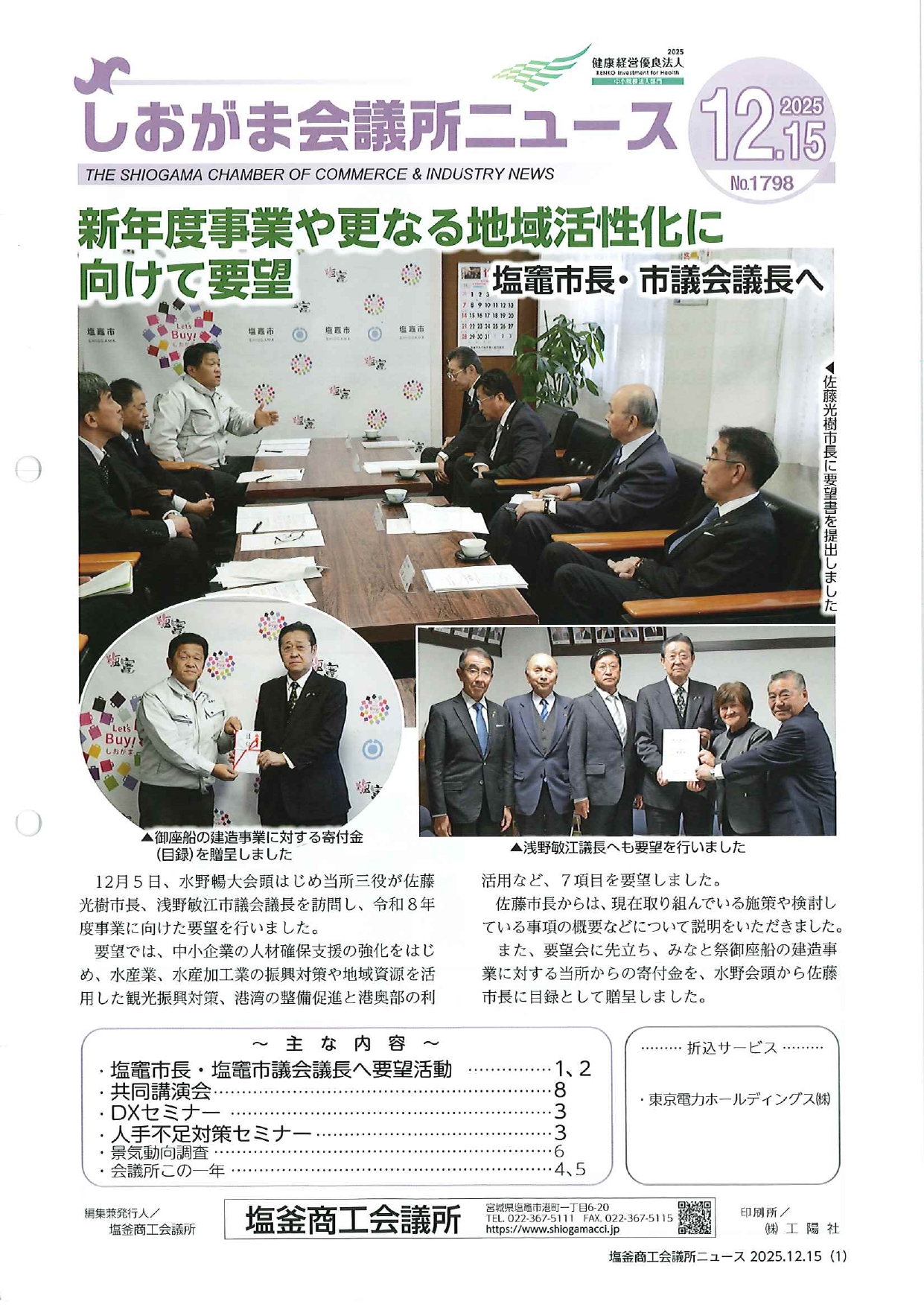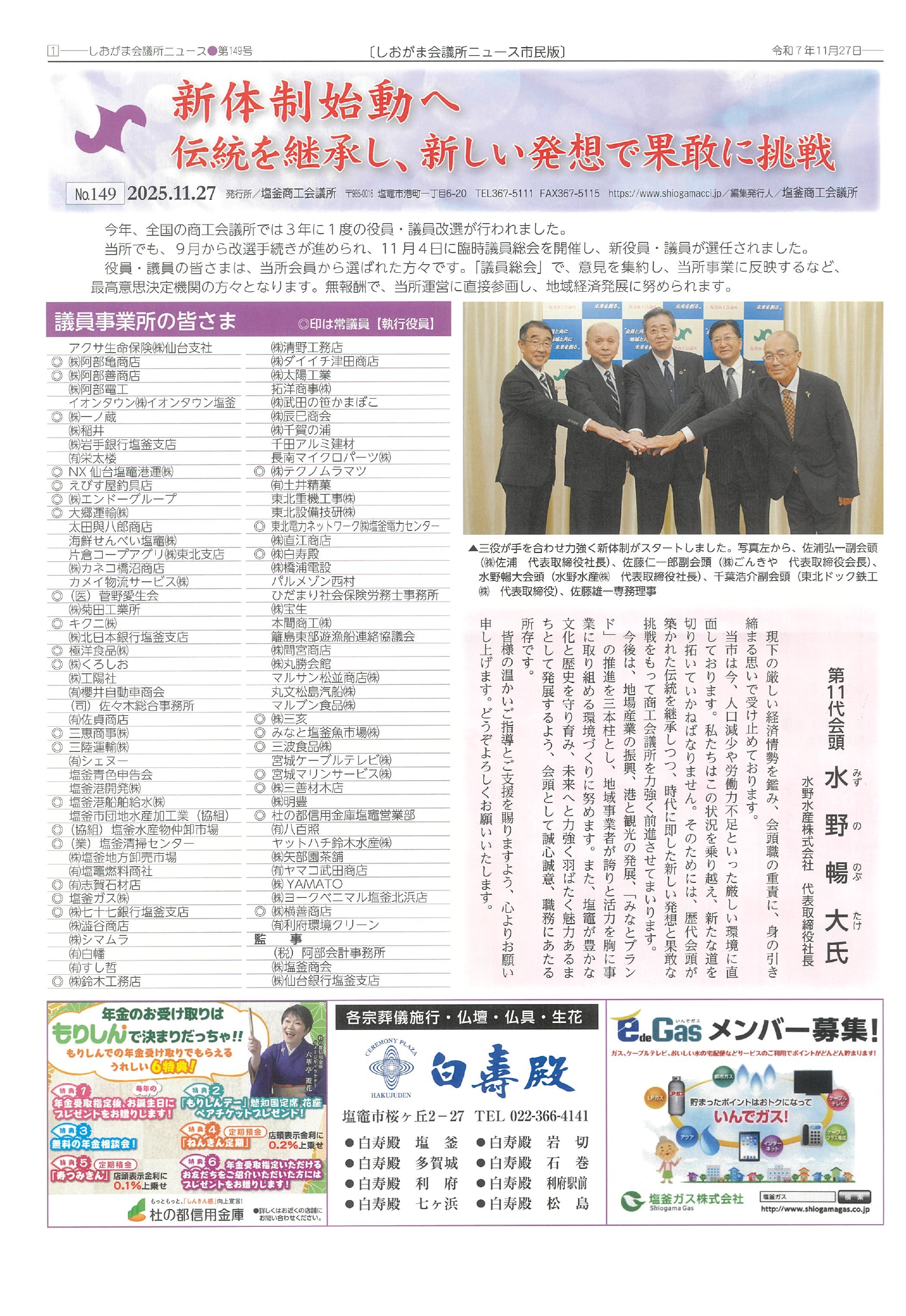裏坂
裏坂(通称女坂)は鹽竈神社への三つの参道のひとつで、距離はやや長いもののゆる緩やかな坂道であったことから、女性や子どもを含む庶民の参詣道として親しまれました。
もともとは江戸時代前期にほう法れん蓮じ寺の僧らが神社に通うため踏み分けた小道が始まりとされています。その後ここを利用する参詣人らが増えるにともない、天保三年(一八三二)に近江商人で仙台城下の豪商であったひの日野や屋なか中い井しん新ざぶ三ろう郎が発起人となり、仙台商人二十八名と塩竈町人一名がこれに協力して坂道の石畳が整備されました。
さらに明治四十一年(一九〇八)、後の大正天皇の巡幸に際し、裏坂入口付近の石畳が整備されました。それに要した資金は総額七千円で、これを塩竈の七十人・仙台の八十人・江戸の七十八人・その他の十六人が分担して拠出していました。これは江戸時代以来の商業の繋がりに基づいたものとみられます。
芭蕉宿泊の地
元禄二年(一六八九)五月八日、当地を訪れた松尾芭蕉らはこの辺りに宿泊しました。同行したそら曽良の日記には「やど宿じへえ治兵衛、ほうれんじもんぜん法蓮寺門前」と記されています。
石の大鳥居
明治のこの付近の改修の際に仙台の豪商であった呉服商人おおうち大内げんたえもん源太右衛門によって寄進されたものです。鳥居は縦、横とも一本の石材からなり、石巻いない稲井の石工によって建てられました。
勝画楼
江戸時代、正面奥の高台に鹽竈神社のべっとうじ別当寺であった法蓮寺があり、たち並ぶが伽らん藍が威容を見せていましたが、明治のはいぶつきしゃく廃仏毀釈によりしょう勝が画ろう楼を除く建物はすべて取り壊されました。
勝画楼は法蓮寺の書院として江戸時代中頃に建てられました。ここからの眺めは絵にも勝るとして伊達吉村公(仙台藩五代藩主)が命名し、歴代の藩主の神社参詣時の休憩所として使われました。さらに明治天皇の東北巡幸に際してあんざいしょ行在所(宿泊所)となり、その後は戦後まで料亭として市民に親しまれていました。
裏坂正面の石碑(歌碑・裏坂改修碑・五重の燈籠) 勝画楼への入口にある石碑は、嘉永六年(一八五三)のごちょう午長の歌碑です。「たえ妙なるや なみ浪のはな華みる ほうれんじ法蓮寺」と刻まれ、この近くまで海が迫っていた様子を伝えています。
正面の大きな石碑は裏坂改修の経緯を記した「裏坂道路改修工事記念碑」で、その左の五重のとうろう燈籠は、大正十年(一九二一)、仙台市の吉田高等女学校(現聖和女学園)の創立に尽力した吉田つぎ女が奉納したもので、広瀬川の自然石を組んで作られたものとのことです。
令和二年三月 文 斎藤善之(東北学院大学教授) 設置 塩釜商工会議所
○英語(English)
History of the Urasaka Slope Area
Urasaka Slope
Urasaka slope (commonly known as Onnazaka) is one of three approaches to
Shiogama-jinja Shrine which is popular among the general public as a prayer
route, particularly for women and children, despite the distance being
a little long, it has such a gentle slope.
It is said that the slope originated from a path which the Buddhist priests
of Horen-ji Temple pushed their way through on their way to the shrine
in the early Edo period. Afterwards, as the number of worshippers using
the path increased, Shinzaburo Nakai of the Hinoya House, who was a merchant
from Omi and a business magnate in the Sendai-jo Castle town, became a
proponent to develop the slope into stone pavement in cooperation with
28 other Sendai merchants as well as 1 Shiogama townsperson in the 3rd
year of the Tempo era (1832).
Furthermore, the cobblestone near the entrance of Urasaka slope was restored
in the 41st year of the Meiji era (1908) for an Imperial visit of the (later)
Emperor Taisho. The funding required for this maintenance amounted to 7,000
yen in total, which was split between 70 people of Shiogama, 80 from Sendai,
78 from Edo city, and 16 others. It is considered to have been made possible
through commercial connections withstanding from the Edo era.
Where the Basho Lodged
Basho Matsuo, who visited these regions with his followers, stayed around
here on May 8 of the 2nd year of the Genroku era (1689). Sora, who accompanied
him, wrote in his diary: “Lodging house Jihee in front of Horen-ji Temple."
The Great Otorii Gate Made of Stone
The Otorii gate was donated by a kimono fabric merchant, Gentaemon Ouchi,
who was a business magnate in Sendai, in honor of the occasion of restoration
works being performed nearby in the Meiji era. The torii was made with
solid stones comprising of both the vertical and horizontal sections, and
was built by a mason from Ishinomaki Inai.
Shogaro
In the Edo era, Horen-ji Temple once stood on the hill right behind Shiogama-jinja
Shrine as its Betto-ji Temple (a place of prayer that combined both Shinto
and Buddhist concepts), and its lined-up temple halls held a dignified
appearance; however they were all demolished, with the exception of Shogaro,
due to the Haibutsu-kishaku (a movement to abolish Buddhism) in the Meiji
era.
Shogaro was built as a study hall for Horen-ji Temple in the middle of
the Edo era. The lord Yoshimura DATE (Sendai Domain’s 5th feudal lord)
named it, stating that the view from the hall was superior to any picture.
The hall was also used as a place to rest during visits to worship the
shrine by the successive feudal lords. Furthermore, it became an Anzaisho
(a temporary lodging) for the Tohoku Imperial tour by Emperor Meiji, after
that local citizens grew familiar with it when it was turned into a restaurant
until the postwar period.
The Stone Monument in front of Urasaka Slope (The Poem Monument, Urasaka
Restoration Monument, and Fivefold Lantern)
The monument at the entrance to Shogaro is inscribed with a poem written
by Gocho in the 6th year of the Kaei era (1853). It is engraved with “Taenaruya/Namino
Hanamiru/Horenji” (when viewed from Horen-ji Temple it appears as if the
sea is blooming with subtle bubbles created by the oncoming waves), and
it conveys that the sea was advancing towards this vicinity during that
period. The large stone marker at the front is “A monument to commemorate
the restoration work performed on the Urasaka slope path” with a description
written about the process behind the Urasaka restoration work, and then
the fivefold lantern on the left of this Urasaka restoration monument was
donated by Tsugijo Yoshida, on the 10th year of the Taisho era (1921),
who made an effort for the founding of the Yoshida Girls' High School (known
presently as the Seiwa Jogakuen) of Sendai City, which is said to have
been made by stacking natural stones from the Hirose-gawa River.
March of the 2nd year of the Reiwa era (2020)
Article by Yoshiyuki Saito (Professor at Tohoku Gakuin University) Organizer:
Shiogama Chamber of Commerce and Industry
○中国語(中文)
裏坂一帶的歷史
裏坂
裏坂(通稱女坂)是前往鹽竈神社三條參拜道之一,雖然這條路稍長,但坡道比較緩,因而深受包括女性和兒童在内一般民眾的歡迎。
據説,這是於江戶時代前期,法蓮寺的僧侶為往返神社而踩出來的小徑。之後,隨著利用該坡道前往神社的參拜者日益增加,於天保3年(1832年)近江商人仙台城下豪商日野屋的中井新三郎作爲發起人與28名仙台商人和1名鹽竈町人共同携手修整了坡道的石板。
於明治41年(1908年)、之後的大正天皇巡幸之際,將裏坂入口附近的石板又加以修整。所需費用總額為7千日元。70名鹽竈人、80名仙台人、78名江戶人以及其他地區的16名人士共同出資分攤了費用。被視爲基於江戶時代以來商業之間合作的結果。
芭蕉留宿之地
元祿2年(1689年)5月8日,松尾芭蕉氏來此訪問并在附近留宿。同行的曾良在日記中這樣記載的:「留宿治兵衛 法蓮寺門前」。
石大鳥居
明治時代,當此地附近改建之際,由仙台豪商吳服商人大内源太右衛門捐獻。該鳥居無論橫竪皆使用整塊石材,由石卷稻井的石匠建成。
勝畫樓
在江戶時代,正面裏面的高台上建有鹽竈神社的別當寺法連寺,裏面供奉著威嚴無比的伽藍菩薩。但是,明治時代發生廢佛毀釋運動,除了勝畫樓之外所有的建築物皆被毀掉。
勝畫樓作爲法蓮寺的書院建於江戶時代中期。從此處放眼遠眺,風景優美勝過畫卷。故伊達吉村 公(仙台藩第五代藩主)將之命名為勝畫樓。一直作爲歷代藩主前往神社參拜之際的休息場所。
另外,明治天皇東北巡幸之際,這裏成爲行在所(下榻之處)。直至戰後爲止作爲料亭(高級日 本料理餐廳)深受市民的喜愛。
裏坂正面的石碑(詩碑、裏坂改修碑、五重燈籠)
勝畫樓入口処的石碑是嘉永6年(1853年)午長的詩碑。上面刻有「妙哉 浪綻花 法蓮寺」這樣的詩句,描寫午長看到海浪拍岸激起朵朵浪花,深受感動的情景。
正面的大石碑是記載裏坂改建過程的「裏坂道路改修工程紀念碑」。左側的五重燈籠是於大正10年(1921年),為仙台市吉田高等女學校(現聖和女學園)創立而盡心盡力的吉田Tsugi女士所捐,採用廣瀨川天然石製作而成。
令和2年(2020年)3月 文 齋藤善之(東北學院大學教授)設置 鹽釜商工會議所
○韓国語(한국어)
우라자카 일대의 역사
우라자카
우라자카(별칭 온나자카)는 시오가마 신사로 가는 3대 참배길의 하나. 거리는 조금 멀기는 하나 비탈길이 완만하여 여성이나 어린이를
비롯한 서민의 참배길로 사랑받았다.
우라자카는 에도 시대(1603-1867) 전기에 호렌지 절의 스님들께서 신사를 다니며 왕래한 샛길이 시초로 전해지고 있다. 그
후 신사를 방문하는 참배자 증가에 따라 에도 말기 덴포 3년(1832)에 오우미 상인이자 센다이 성읍의 호상 히노야 나카이 신자부로(日野屋
中井 新三郎)가 발기인이 되어 센다이 상인 28명과 시오가마 상인한 명이 협력해 비탈길을 돌 포장길로 정비했다.
또한, 메이지 41년(1908), 후의 다이쇼 천황 순행에 맞추어 우라자카 일대의 돌 포장길이 정비되었다. 정비에 든 자금은
총액 7천 엔이었고, 이 자금을 시오가마의 70명·센다이의 80명·에도의 78명·그 외 16명이 분담해 갹출했다. 이 일은 에도시대부터
이어진 상업의 유대에 의해 실현된 것으로 여겨진다.
바쇼 숙박의 땅
겐로쿠 2년(1689) 5월 8일, 이 지역을 방문한 마쓰오 바쇼(松尾 芭蕉) 등은 이 근처에서 숙박했다. 동행한 소라(曽良)의
일기에는 <숙소 지헤, 호렌지 절 앞>이라 기록되어 있다.
돌의 오토리이
메이지 시대(1867~1912), 이 일대를 개수할 때 센다이의 호상이자 포목 상인 오우치 겐타에몬(大内 源太右衛門)이 봉납했다.
신사 앞 기둥 문은 세로 기둥, 가로 기둥이 각각 한 덩어리의 석재로 구성되어 있으며 이시마키 이나이의 석공에 의해 축조되었다.
쇼가로
에도시대(1603-1867), 정면 안쪽의 고지에 시오가마 신사의 별당 절인 호렌지 절이 자리하고, 죽 늘어선 가람이 위용을
선보이고 있었다. 그러나 메이지 시대(1867~1912)의 불교 배척 정책으로 쇼가로를 제외한 건물은 모두 해체되었다.
쇼가로는 호렌지 절의 서원으로서 에도 시대 중순에 축조되었다. 이곳에서부터의 경치는 그림보다 우월하다 하여 다테 요시무라 공(伊達吉村公,
센다이번 제5대 영주)이 쇼가로(勝画楼)라 명명, 역대 지방 영주의 신사 참배 때 휴식처로써 이용되었다. 메이지 천황의 도호쿠
지역 순행 때는 행궁(숙박소)으로 이용. 그 후, 제2차 세계대전 후까지 요릿집으로서 시민에게 사랑받았다.
우라자카 정면의 비석(노래비·우라자카 개수비·오중 등롱)
쇼가로 입구에 세워진 비석은 가에이 6년(1853) 고초(午長)의 와카(일본 고유 형식의 시)를 세긴 노래비이다. ‘말할 수 없이
아름답도다 파도에 피는 꽃들이여 호렌지 ’라 새겨져 바로 근처까지 파도가 몰려온 모습을 노래로 표현했다.
정면의 큰 비석은 우라자카 개수의 경위를 기록한 <우라자카 도로 개수 공사 기념비>이다. 그 왼쪽의 오중 등롱은 다이쇼
10년(1921), 센다이시의 요시다 고등 여학교(현 세이와 여학원) 창립에 진력한 요시다 쓰기(吉田つぎ) 여사가 봉납한 것으로
히로세가와 강의 자연석으로 만든 등롱이다.
2020년 3월 글 사이토 요시유키(斎藤善之, 도호쿠 학원대학 교수)
설치 시오가마 상공회의소
















